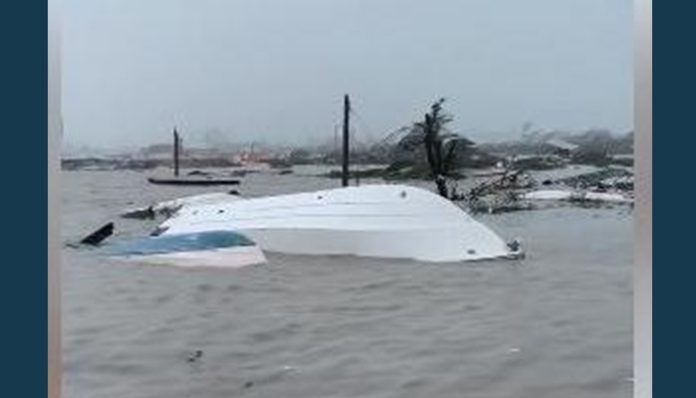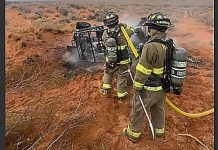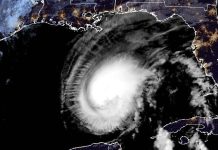
Sept. 2 (UPI) — Hurricane Dorian, the strongest storm ever to hit the Bahamas, may have destroyed 13,000 homes in the island nation and knocked out water supplies, the Red Cross said Monday.
“On the island of Abaco, extensive flooding is believed to have contaminated wells with saltwater, creating an urgent need for clean water,” a report from the agency said.
“We don’t yet have a complete picture of what has happened. But it is clear that Hurricane Dorian has had a catastrophic impact. We anticipate extensive shelter needs, alongside the need for short-term economic support, as well as for clean water and health assistance,” said Sune Bulow, head of the International Red Cross Emergency Operation Centre in Geneva, Switzerland.
The American Red Cross said it was helping to prepare local evacuation centers expecting to see about 60,000 people in Florida, Georgia, South Carolina and North Carolina. Dorian is expected to graze the Florida coast as it turns north.
As of Sunday night, the agency said about 2,600 evacuees had sought refuge in 60 Red Cross and community evacuation shelters in Florida. It was mobilizing over 1,600 trained volunteers from all over the country to help.
The storm continued battering the Bahamas on Monday, all but grinding to a halt over Grand Bahama Island as the storm stalled it’s forward progress to just 1 mph.
On Sunday, Dorian turned deadly as it leveled a devastating strike on the Bahamas after strengthening to Category 5 force.
The storm, which left many communities underwater, made landfall on three different islands with punishing sustained winds of 185 mph and gusts that reached speeds of 225 mph.
Late Sunday night, the first fatality blamed on Dorian was confirmed in Abaco. Lachino McIntosh, a young boy, drowned and his sister remains missing, according to The Bahamas Press.
“All I can say is that my daughter called from Abaco and said that her son — my grandson — is dead,” the boy’s distraught grandmother, Ingrid McIntosh told Eyewitness News in the Bahamas. “That’s it. I don’t know what really happened. I think she said he drowned.”
She continued through tears, saying, “My grandson is dead,” adding that she’d just seen him two days ago.
The Bahamas Press reported that there was a “growing wall” of photos and notes from residents frantically looking for information about loved ones.
On Monday morning Dorian had stalled about 115 miles east of West Palm Beach, Fla., and only 30 miles east of Freeport in Grand Bahama Island. By Monday afternoon, winds dropped to 150 mph — still a dangerous, strong Category 4 storm.
In Freeport on Grand Bahama Island, residents hunkered down in a church that was being used as a makeshift shelter. Photos and videos surfacing on social media began to reveal a peek at what the devastation on the small islands looks like.
Toppled trees, downed power lines, flooding in the streets, and severe structural damage to homes were visible.
Dorian’s relentless impacts continued to be felt across the northern islands on Monday morning. The Bahamas Press reported that Grand Bahama International Airport was inundated with at least 5 feet of water.
In addition to some places in the Bahamas seeing up to 30 inches of rain, severe storm surge could be devastating.
AccuWeather forecasters say Dorian will move away from the northern Bahamas slowly, and dangerous hurricane conditions would continue across Grand Bahama through Monday before gradually improving Monday night into Tuesday.
Dorian proved to be a historic hurricane, the strongest ever during modern record-keeping to make landfall in the Bahamas and, with sustained 185-mph winds, it’s now the second-strongest hurricane, by wind speed, ever recorded in the Atlantic basin.
Dorian now stands behind only Hurricane Allen, the strongest storm ever recorded in the Atlantic basin. Allen thundered over the Gulf of Mexico in August 1980 and reached sustained wind speeds of 190 mph before making landfall near the U.S.-Mexico border.
Hurricane Dorian made its initial landfall at Elbow Cay in the Abaco Islands area of the Bahamas. The eye of Dorian then made a second landfall on Great Abaco Island near Marsh Harbour in the Bahamas.
The third landfall came later on Sunday night, the eye encroaching the eastern end of Grand Bahama Island. Maximum sustained winds were 185-mph during the first two landfalls, dropping to 180 mph for the third. Gusts of 225, as AccuWeather Extreme Meteorologist Reed Timmer pointed out, were equivalent to the winds of an EF4 tornado.





